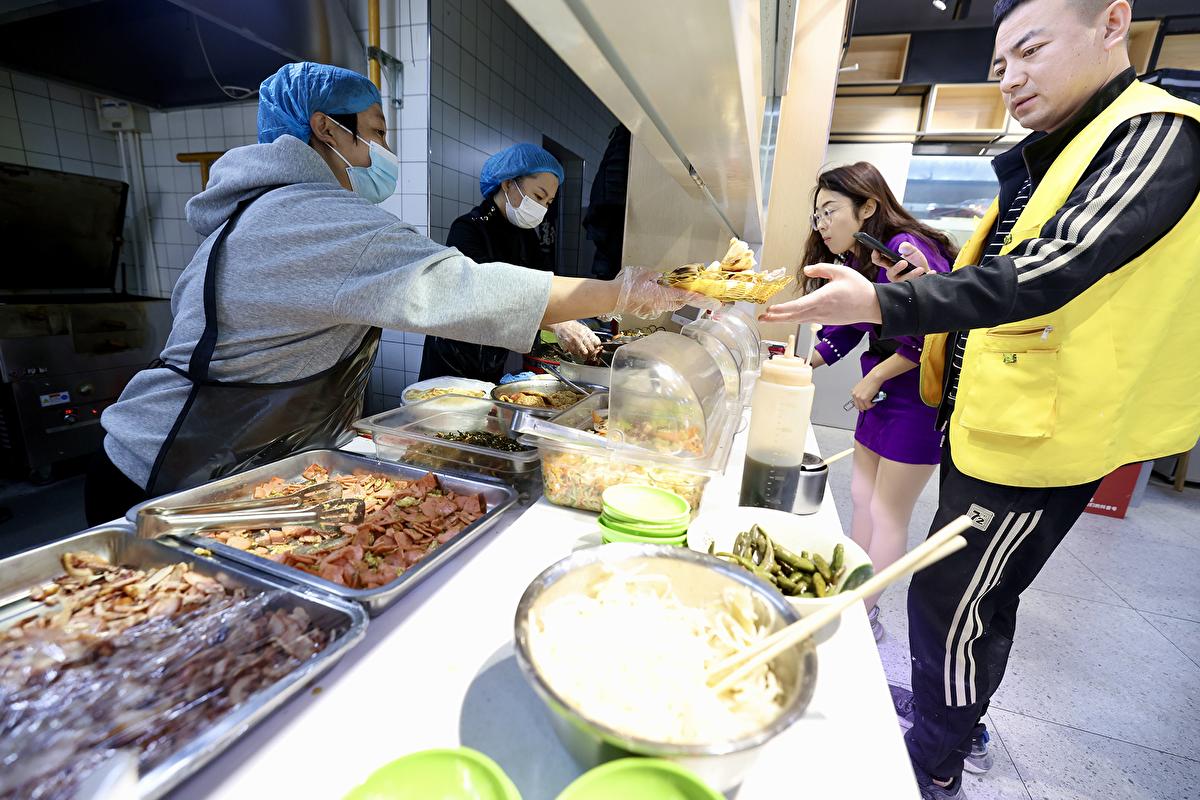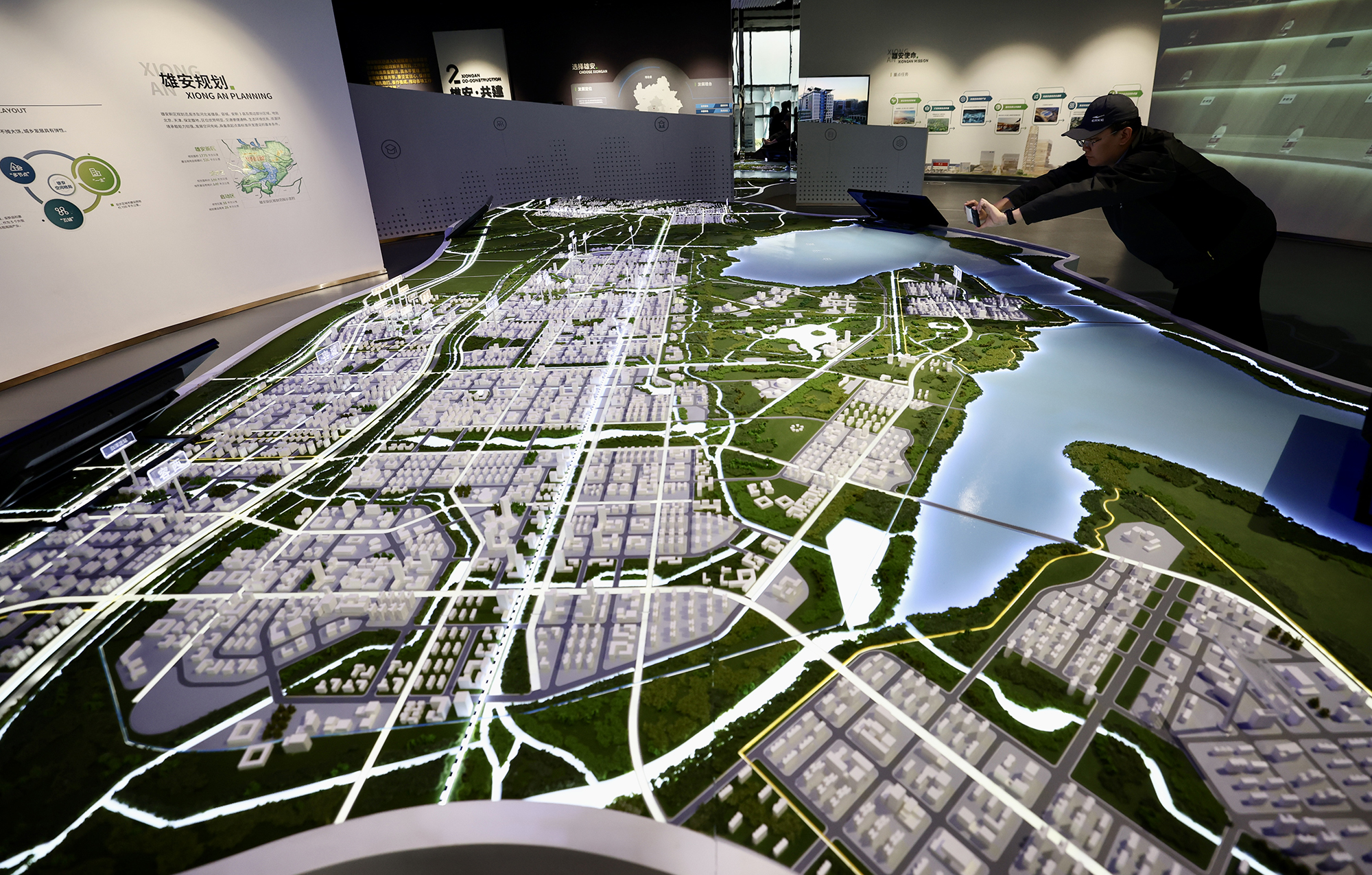Xiong’an New Area, in Hebei province, enters next stage of tech-powered high-quality development

Chen Xueying has become accustomed to taking the autonomous driving bus to and from work every day by clicking on her phone to book in advance.
It is not a scene out of a science-fiction film, but the reality of her life in Rongdong district of Xiong’an New Area in Hebei province.
“It’s safe and free,” the 27-year-old Xiong’an resident said, adding that the bus trip takes just over 10 minutes and is much more convenient than driving to work in rush hour.
The autonomous driving buses are capable of sensing traffic information, such as stoplights, within a 240-meter range.
They can respond to sudden situations by braking or changing lanes with a reaction speed 10 times faster than that of a human driver, said Kou Tianhao, from Yuexiang Xiong’an Technology Co, which operates the vehicles.
“It’s a Level 4 autonomous driving bus independently developed by the company, which is currently the highest level of autonomy achieved by such technology in China,” he said.
The level of autonomous driving vehicles ranges from 0 to 5, with Level 4 not requiring human intervention and Level 5 classified as fully autonomous.
The buses are equipped with over 20 sensing devices including laser radar and high-definition cameras, which constantly capture traffic information and then transmit the data to a decision-making central computer.
However, a safety officer is onboard to intervene in operations when absolutely necessary, Kou said.

About 20 such vehicles are running on routes connecting residential communities, major parks and transportation hubs in Rongdong district. The successful operation of these autonomous vehicles relies heavily on the construction of digital roads.
Rongdong is the first district to complete comprehensive digital road construction in Xiong’an New Area, according to the government.
Along its 153 kilometers of roads including main, secondary and branch roads, and alleys, there are multifunction information poles, laser radars, electronic toll cameras and other sensing devices, as well as supporting intelligent equipment to monitor the roads and transmit and analyze data.
More districts including Xiongdong, Rongxi and a startup area will also introduce digital roads, making the total length of such roads more than 500 kilometers in Xiong’an New Area, a government website said.
City traffic data obtained from various sources such as the sensing devices, will be brought together in a unified platform for integration and display.
The Digital Road Intelligent Operation Center utilizes big data analysis and algorithms to address problems in traffic management, according to China Telecom Digital City Technology, the operating company.
“The center will utilize algorithm models to optimize signal-light timing to improve vehicle movement efficiency and reduce traffic congestion,” said Feng Shuntian, head of the company’s intelligent transportation products division.
The center’s data analysis might also help traffic management departments to have a better understanding of traffic flow, and make advance preparations and scheduling arrangements, Feng added.

Digital roads and the intelligent operation center have presented effective solutions for Xiong’an to address traffic problems, one of the drawbacks of “big city malaise” that the area was designed to solve.
The establishment of Xiong’an New Area — located about 100 kilometers southwest of Beijing — was announced in April 2017.
The flagship project was intended to relieve Beijing of nonessential capital city functions and advance the coordinated development of the Beijing-Tianjin-Hebei region.
Xiong’an New Area has built a digital twin city, which mainly operates in the Xiong’an Urban Computing Center. Since it began operations at the end of 2022, it has offered network, computing and storage services for big data, blockchain and the internet of things.
The Digital Road Intelligent Operation Center is also part of the twin city, said the operating company Xiong’an Cloud Network Technology.
“In the process of construction, Xiong’an needs to introduce a large amount of information-based management methods like digital roads, and the data generated by these methods can be aggregated and integrated in the center, which will provide city management with a more scientific basis for governance,” said Wang Yudong, deputy general manager of the company.
For example, if a residential building catches fire, the city-operations inspection platform immediately calculates the coverage area, affected people and key areas, and then provides the best route for firetrucks to access the fire and checks nearby water pressure.
Wang said that with the permission of families, the center can also monitor the water utilization of elderly people who live alone.
“Once no water use is detected in certain hours, an automatic alert is sent to community volunteers who check on the elderly people,” he said, adding it is just one of the applications that uses the data.
“We can better serve the people and the city with various types of smart-city management applications,” he said.

Feng, from the digital road intelligent operator, said his company had developed a non-motor vehicle behavior monitoring system in Cangzhou, Hebei, by using algorithms and big data technology. The system can detect other road users such as electric scooters.
“The Xiong’an New Area serves as a testing ground, where we pioneer initiatives and gradually inspire neighboring areas to embark on smart city construction,” said Hu Junjun, head of the company’s research and development department.
The development of Xiong’an New Area has shifted from the initial planning and construction stage to focus on high-quality construction, high-level management and the high-quality transfer of the noncapital city functions from Beijing.
“In just six years, the Xiong’an New Area has transitioned from mere concept to palpable reality,” President Xi Jinping said during an inspection tour in May 2023.
“A highly modernized city rising from the ground is nothing short of miraculous.”
Xi, who is also general secretary of the Communist Party of China Central Committee and chairman of the Central Military Commission, also underlined the importance of promoting high-quality development and building the area into a “city of the future”, a hub for innovation and entrepreneurship, and a model of green development.
Centrally administered State-owned enterprises have so far set up more than 200 subsidiaries and branches in Xiong’an, demonstrating the area’s viability and stimulated agglomeration, said Xiong’an’s Reform and Development Bureau.
Zhongshi Boxing Technology, where Li Nan works as head of marketing, has focused on implementing AI digital human scenes, which can be applied in livestreaming sales, hospitals, and schools to provide basic information.
“We are optimistic about the innovative entrepreneurial atmosphere and promising market here, therefore, we partially relocated a team from Beijing to Zhongguancun Science Park in Xiong’an in January,” he said, adding his wife and daughter had also moved to the area.

Xiong’an is also attracting business people and innovation companies from around the world.
“I see a lot of prospects and opportunities in this city,” said Godsword George Chinemerem from Nigeria who has set up a logistics company in Xiong’an. He plans to ship goods from Xiong’an to African markets via Tianjin Port.
Omane Vincent Kwakye from Ghana also sees his future in Xiong’an where the cost of living and doing business is more conducive for startups. He plans to bring technological advances to African countries.
“Besides, Xiong’an is focusing on sustainable energy and it will need certain natural resources from Africa. I plan to bring materials like cobalt and lithium into China,” he said.
With an increasing number of startups, Xiong’an has welcomed the arrival of new talent and has rolled out comprehensive measures to ensure its development.
So far, 16 policy measures have been announced to attract global talent, including top scientists, high-level research teams and new university graduates. Eligible leading scientists can receive research funding of up to 50 million yuan ($6.9 million).
“The talent pool and structure are crucial for the future development of Xiong’an New Area, and our comprehensive measures to attract talent have worked,” said You Zhijun, director of the Party-mass Work Department of the Administrative Committee of Xiong’an New Area, who is in charge of talent issues.
You said they have had a strong response to the talent drive, with a significant increase in the number of people who have arrived in Xiong’an or inquired about moving there.
Since April 2017, over 10,000 Xiong’an talent cards have been issued. The card is an official document granted to talented people, and since 2023 Xiong’an has witnessed the arrival of 30,000 startups and entrepreneurs, according to the department.

Fu Chaoyang, who has a talent card, said his telecommunications and 5G technology business has thrived in the innovation-driven city.
“It has gathered more talented people with preferential policies and efficient support measures, which allow more startups to find the people they need quickly and explore cooperation opportunities,” he said.
During the construction of Xiong’an, the top leadership urged implementing and refining policies and measures concerning children’s education, healthcare, housing and other public welfare issues to fulfill the needs of residents.
Mi Yinuo, a first-year student at the Xiong’an branch of the Beijing No 4 High School, is getting some practical life lessons.
“It was quite interesting to gain some ‘boring’ insurance knowledge when we played monopoly in our elective course,” she said.
When she received “lucky money” for Spring Festival, she deposited it in a bank account to earn interest, rather than keeping it in a purse.
Twenty other elective courses including Pilates have been introduced, and various activities such as walking have been promoted on campus to nurture the children’s all-around development, said the principal, Huang Chun.
The first intake of about 50 students has been enrolled since September. The teachers have mentors at the main campus in Beijing, which has regular interaction with the Xiong’an branch and provides support to ensure high-quality education.
“My son’s outlook has grown in just one semester and he’s now able to speak in public with more confidence,” said Weng Junwu, father of one of the students.
A kindergarten and a primary school, both branches of Beijing educational institutions, also started recruiting students in September and aim to provide quality education for the relocated families from Beijing.
In addition, 15 Beijing universities will establish new campuses in Xiong’an, and four of them, including Beijing Jiaotong University, started construction in November.
Xiong’an has also seen an improvement in medical services, especially after the branch of Beijing-based Xuanwu Hospital, affiliated to the Capital Medical University, started trial operations in October.
“The hospital has opened 30 departments and expects to gradually open the inpatient wards and operating rooms and then the emergency room,” said Liu Dongbin, deputy director of the branch.
The hospital has introduced innovations to improve its medical services, and the number of cumulative outpatient visits has reached approximately 35,000, he said.
Kang Hua, director of the hospital’s breast treatment center, has witnessed the growing satisfaction of patients who also have easy access to experts from Beijing.
Weng Junwu said the improved medical services in the area offered assurance for his family about living in Xiong’an, where he hopes his son will eventually attend university.
“I’m honored to witness the overall improvement, and grow with Xiong’an,” he said.
Contact the writers at zhengjinran@chinadaily.com.cn


